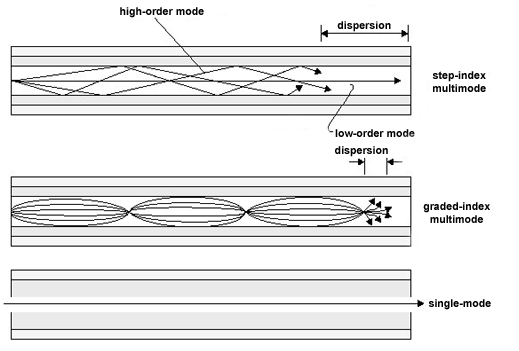Optical fiber is a flexible transparent fiber made of extruded glass or plastic, which is slightly thicker than human hair. Optical fiber is the most commonly used method for transmitting light at both ends, and is widely used in optical fiber communication. Optical fiber has a longer transmission distance and higher bandwidth than wired cable. Optical fiber usually consists of a low-refractive-index transparent core and a transparent cladding material. The optical fiber acts as a light wave conductor, which causes total reflection of light in the fiber core.
Generally speaking, there are two kinds of optical fibers: those that support multiple propagation paths or transverse modes are called multimode fibers (MMF), and those that support a single mode are called single mode fibers (SMF). But what is the difference between them? Reading this article will help you get the answer.
1. What is single-mode fiber?
In optical fiber communication, single-mode fiber (SMF) is an optical fiber that directly transmits optical signals in a lateral mode. Single-mode fiber runs at a data rate of 100M / s or 1 G / s, and the transmission distance can reach at least 5 kilometers. Normally, single-mode fiber is used for remote signal transmission.
2. What is multimode fiber?
Multimode fiber (MMF) is mainly used for short-distance fiber communication, such as in buildings or campuses. Typical transmission speed is 100M / s, transmission distance can reach 2km (100BASE-FX), 1 G / s can reach 1000m, 10 G / s can reach 550m. There are two types of refractive index: graded index and step index.
3. What is the difference between single-mode and multimode fiber?
1. Core diameter
The main difference between multimode and single-mode fiber is that the former has a larger diameter, usually a core diameter of 50 or 62.5 µm, while a typical single-mode fiber has a core diameter of 8 and 10 µm, the package of both The layer diameters are all 125µm.
2. Light source
Usually laser and LED are used as light sources. Laser light sources are significantly more expensive than LED light sources because the light it produces can be precisely controlled and has high power. The light generated by LED light sources is more dispersed (many modes of light), and these light sources are mostly used in multimode fiber jumpers. At the same time, the laser light source (which produces light close to a single mode) is usually used for single-mode fiber jumpers.
3. Bandwidth
Because multimode fiber has a larger core size than single mode fiber, it supports multiple transmission modes. In addition, like multimode fibers, single-mode fibers also exhibit modal dispersion caused by multiple spatial modes, but the modal dispersion of single-mode fibers is less than multimode fibers. For these reasons, single-mode fiber has a higher bandwidth than multimode fiber.
4. Sheath color
The color of the jacket is sometimes used to distinguish multimode fiber jumpers from multimode fiber jumpers. According to the TIA-598C standard definition, for non-military applications, single-mode optical fibers use a yellow outer jacket, and multi-mode optical fibers use an orange or aqua-green outer jacket. According to different types, some manufacturers use purple to distinguish high-performance OM4 fiber from other types of fiber.
5. Modal dispersion
LED light sources are sometimes used in multimode fiber to create a series of wavelengths that propagate at different speeds. This will result in multi-modal dispersion, which limits the effective transmission distance of multi-mode fiber jumpers. In contrast, the laser used to drive a single-mode fiber produces a single wavelength of light. Therefore, its modal dispersion is much smaller than multimode fiber. Due to modal dispersion, multimode fiber has a higher pulse expansion rate than single mode fiber, which limits the information transmission capacity of multimode fiber.
6. Price
For multimode fiber can support multiple optical modes, its price is higher than single mode fiber. But in terms of equipment, since single-mode fiber usually uses solid-state laser diodes, the equipment of single-mode fiber is more expensive than the equipment of multimode fiber. Therefore, the cost of using multimode fiber is much less than the cost of using singlemode fiber.
4. What kind of fiber should be selected?
Consider the transmission distance covered and the overall budget. If the distance is less than a few miles, multimode fiber will work well, and the cost of the transmission system (transmitter and receiver) will range from 3300 yuan to 5300 yuan. If the covered distance exceeds 6-10 kilometers, single-mode fiber should be selected, but due to the increased cost of laser diodes, the cost of the transmission system will usually exceed 6700 yuan.












